DIEPPE-NEWHAVEN
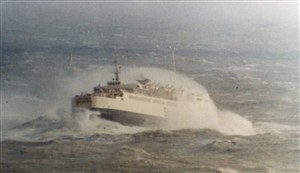
Not Senlac, but this is what Bruce was up against.
Phil James, courtesy of Newhaven Museum.
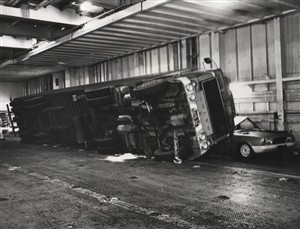
This artic has broken its lashing chains
Kind permission of Nigel Thornton
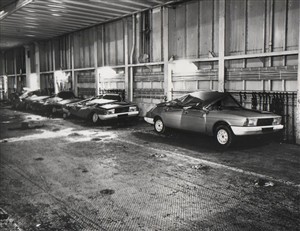
Flat as a pancake seems to be the right caption here!
Kind permission of Nigel Thornton
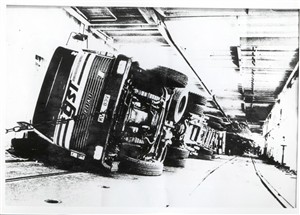
And all these artics went over.
Courtesy of Newhaven Museum
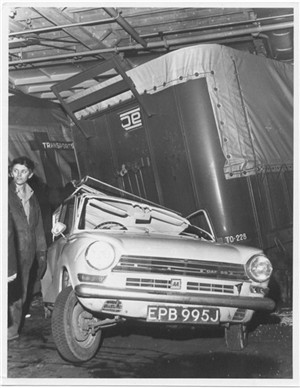
Car deck damage
Mick Cutler
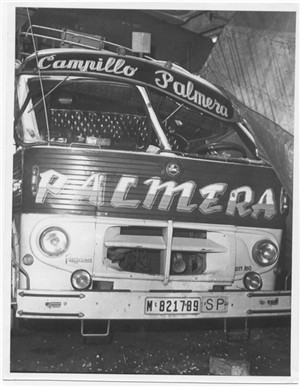
Damaged artic cab
Mick Cutler
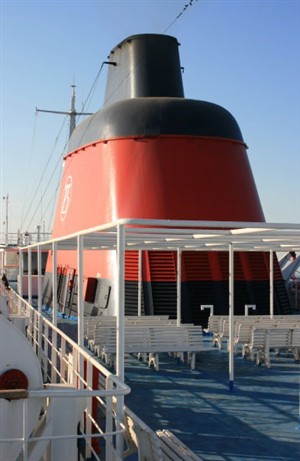
'Does my funnel look big in this?' A close-up of Senlac's large 'Rogan' funnel (seen later in her life as M.V. 'Apollon'.)
Kind permission of hhvferry.com
Some heavy-weather incidents; 1970s and 1990s
By Bruce Macphee
One unremarkable afternoon during the winter of 1973/4, Senlac left Dieppe under a cloudless sky. In command was Capt. Levesley and David Lower was on his first duty as Chief Engineer; other staff “down below” that I remember were Peter Franklyn, Bob Bowen (son of Capt. Reg), Alan Davey and Ray Griffiths. About half-way across, the bridge called the engine room to say that a bad blow was imminent and requested that we put on maximum propeller pitch to try and outrun it. By the time we were a couple of miles off Newhaven, there were heavy seas running and, with little water under the keel, the Master decided to heave-to west of the breakwater until the tide made or the wind dropped. When, in due course, he made his approach, the wind strength increased and, as the ship turned, she pitched and rolled so violently that the screws came out of the water and the main engines cut-out on over-speed. As he struggled to regain the open sea, the engines repeatedly cut-out and we were reaching the point where we had insufficient starting air, until someone had the presence of mind to wedge the trips to stop them operating.
On the garage deck, there was a scene of mayhem: several of the drops (unaccompanied semi-trailers) had broken their lashing chains and were thrashing about as the ship rolled; the landing-legs of one had collapsed and the front of the trailer had squashed a lady’s car. Sheets of steel-plate had broken through the side of a lorry and had sliced through the ship’s fire-main, rendering the whole system useless. The galley was wiped-out, but catering staff kept us going with sandwiches; access to the accommodation from the engine room was normally via the garage deck, but this had become a no-go zone, so we had to climb up the escape in the casing when we had a meal relief. Apart from the ruptured fire-main, I don’t think there was too much damage to the ship; one of the older hands opined that, had it been Falaise, it would have been the end. Until this time, Newhaven boasted a record of never missing a sailing; this incident gave the powers-that-be something to think about, and discretion took the place of valour thereafter.
In passing, I would mention that, at the design stage, one of the Masters asked why the new ship needed such a large funnel (the interior was like a two-up, two-down house, and it only contained the exhaust uptakes and a fairly small water header tank); the large surface area would act like a sail and make it difficult to hold a course in a strong crosswind. The answer he received was that “our customers like to see a large funnel on a ship”; I don’t know if passengers cared about the size of the funnel, but Management might have reflected upon this later:
About a year after this incident, a family returning from holiday arrived at Dieppe and were pleased to be allowed onto Senlac despite the fact that they were booked on a later crossing. They had over-stayed their time in France and would have been in trouble for being absent from work; catching this earlier ship might just save the day. Again, we were dogged by bad weather and, it being low tide by the time we reached Newhaven and with winds so strong that we would not have been able to maintain the narrow channel, we steamed off to westward. The cruel irony was that the V-boat that this family should have caught later steamed into Newhaven with no difficulty (we can only guess if its less impressive funnel might have had some part to play in this!) I don’t remember why, but we returned to Dieppe, eventually docking in Newhaven 24 hours late, and with empty bunkers. For no good reason, I left Senlac in 1977, so don’t have first-hand knowledge of subsequent events.
August Bank Holiday 1993(?): Un-seasonal storms. Approaching Newhaven and again at low water, Stena Londoner headed west toward the Owers and hove-to, head to wind. Apart from pitching, she was quite comfortable and I don’t know what else could have been done. One lady passenger became hysterical, and the Bo’sun took her on deck and stayed with her. When she had calmed down a little, she said to him “we are all going to die; I have seen it in the Captain’s eyes that he knows this, but he can’t admit it”.
If I remember correctly, we docked again a day late. The following day’s newspapers had stories of “terrified passengers’ ordeal” (most weren’t so terrified that they couldn’t eat the free breakfasts that the catering dept provided!). That weekend, people ashore had been killed by falling trees and cars blown off the road; I don’t know what would be expected not to happen on the water!
There were other occasions when weather and tide prevented Londoner entering Newhaven. Some of us would consider that heaving-to (as before) would be the best course of action but, on subsequent occasions, we steamed off to Dover to join the queue of waiting ships. Eventually berthing at the Admiralty Pier, we had several vehicles damaged during discharge, and then the long slog back to Newhaven. So, damage compensation, an extra 10-20 tons of fuel burnt and the possibility of two crossings lost. Public relations dictate that you must be seen to be doing something, even when it might be better to do nothing!
From Mick Cutler:
I was on board this trip [on Senlac] & Ray Griffiths was my watch mate, the date was January 16th 1974.
Here are a couple of photos of the damage on the car deck. One is of Dave Strong AB, the other being a Spanish lorry with its cab stoved in because of a semi trailer laying on it.
Alas, rough weather photos of Senlac or Stena Londoner seem to be non-existent. I've tried all my usual sources. Andy-Editor